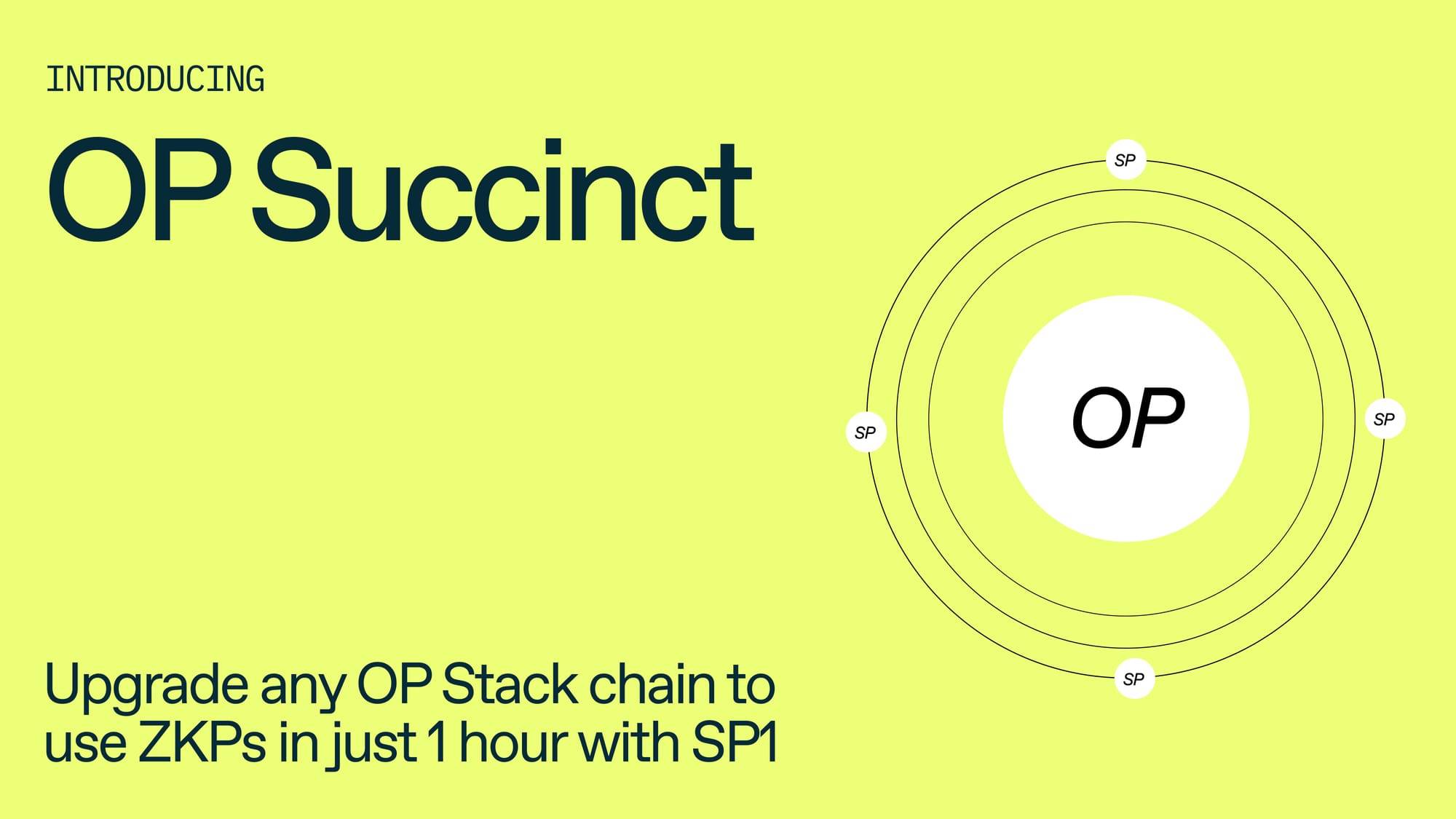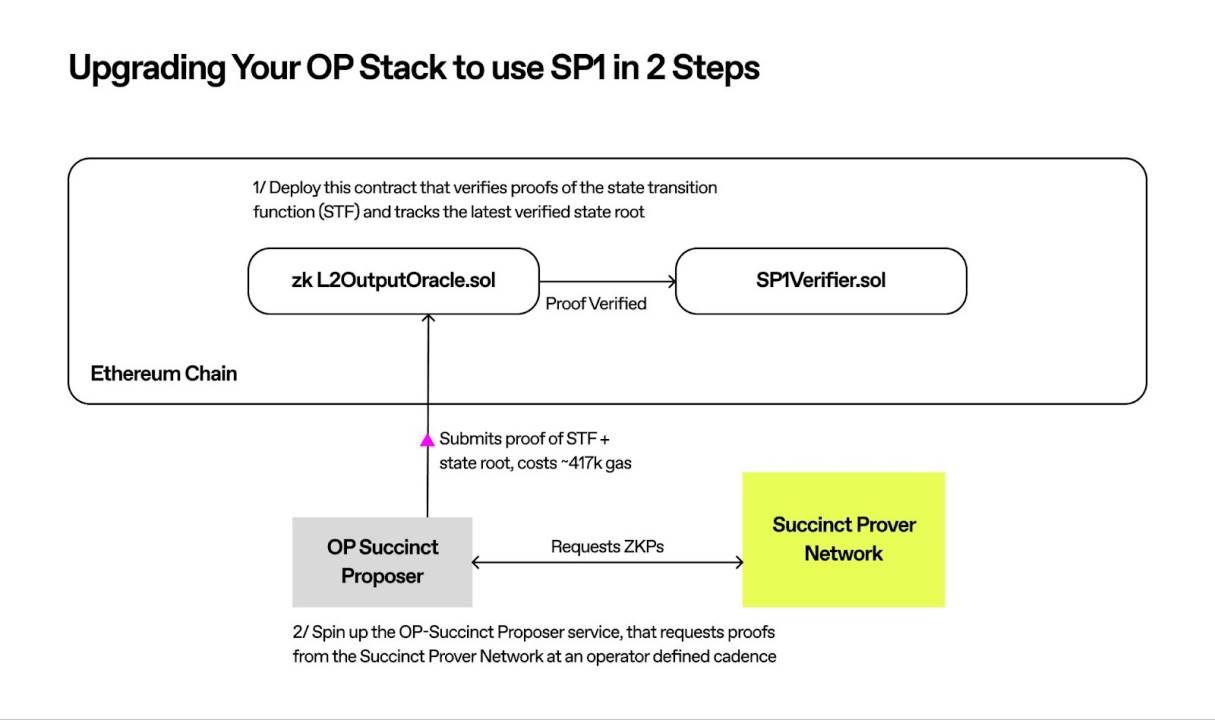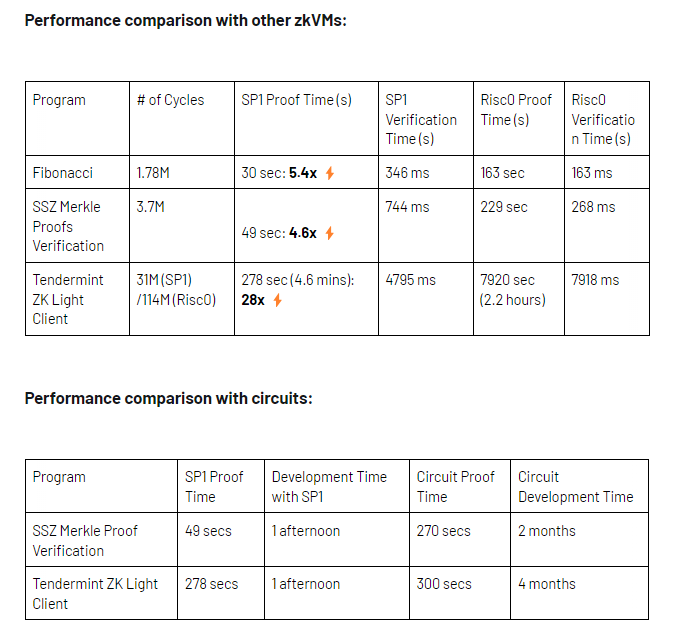OP Succinct: Can it become the killer move of OP Stack against ZK Stack?
Author: YBB Capital Researcher Ac-Core

TL;DR
The main function provided by OP Succinct is to integrate ZKP into the modular architecture of OP Stack to transform OP Stack Rollup into fully verified ZK Rollup;
If the ultimate goal of Ethereum's future expansion is to transform every Rollup into ZK Rollup, the purpose of OP Succinct is to deploy Type-1 zkEVM (fully Ethereum equivalent) of OP Stack by combining Rust and SP1;
OP Succinct Proposer mainly completes parallel proof generation and proof aggregation and verification;
The existing system of OP Stack relies on a "7-day anti-fraud window". In case of disputes, the transaction verification will be postponed for a week. OP Succinct uses ZK proofs to shorten the time required for transaction completion, eliminating the need to extend the anti-fraud window;
OP Succinct can greatly reduce transaction costs.
1. Recent Review: Recent developments of OP Mainnet and the relationship between OP Stack and OP Labs

Source: Blockscout
1.1 Key developments of OP Mainnet
According to the news on March 30, 2024, OP Labs released "fault proofs" on the OP Sepoila test network and officially launched fault proofs on the OP Mainnet on June 11, 2024, advancing decentralization to the first stage. This allows users to withdraw ETH and ERC-20 tokens from the OP Mainnet, enabling them to challenge and remove invalid withdrawals (including Base, Metal, Mode, and Zora) without the need for a trusted third party.
To ensure the security and trust of user assets, Optimism uses fault proofs to improve the accuracy and validity of on-chain transactions and prevent malicious behavior. The principles include:
Data availability: Fault proofs first ensure that all data on Layer-2 is accessible and can be verified by Layer-1;
Challenge period: Within a certain challenge period, anyone can raise objections to the data on Layer-2.
If someone finds inconsistencies between the data on Layer-2 and Layer-1, they can raise a challenge. Proof submission: If there is an objection, Layer-2 operators need to submit proof to refute these objections and prove the correctness of their data; Finality: If there are no valid objections during the challenge period, or if Layer-2 operators successfully refute the objections, the transaction will be finalized and deemed valid.
1.2. The relationship and differences between OP Stack and OP Labs
OP Labs is the team or organization developing the Optimism solution, while OP Stack is a technical framework for building and expanding Ethereum's Layer 2 network. The relationship between OP Labs and OP Stack can be understood as the relationship between developers and their development tools.
OP Labs
OP Labs is a core contributor to the Optimism project, responsible for developing and maintaining the Optimism Layer 2 solution. It is a team or organization focused on building and improving technical tools related to Ethereum's scalability, such as Optimistic Rollups. The main goal of OP Labs is to alleviate the load on the Ethereum mainnet through Layer 2 scaling solutions, reduce transaction costs, and increase transaction speed. OP Labs also collaborates with other projects (such as Succinct Labs) to further advance Ethereum scaling technologies, such as OP Succinct, which focuses on optimizing zero-knowledge proofs.
OP Labs is the primary team or organization developing and maintaining the Optimism network. Their goal is to build an efficient solution for scaling Ethereum, focusing on reducing transaction fees and increasing transaction speed. They are responsible not only for the development of Optimistic Rollups but also actively promote new technologies related to zero-knowledge proofs, such as collaborating with Succinct Labs on OP Succinct.
OP Stack
OP Stack is a modular architecture or technology stack for building and expanding Ethereum's Layer 2 network. It consists of multiple customizable components that allow developers to build their own Layer 2 chains according to specific requirements. It provides a standardized way for developers to quickly build Layer 2 scaling networks that meet specific conditions.
OP Stack is a modular framework developed by OP Labs. This framework provides the infrastructure for building Layer 2 networks, allowing developers to quickly build different scaling networks using OP Stack. Due to the modular design of OP Stack, it allows users to flexibly choose different verification mechanisms (such as Optimistic Rollups or ZK Rollups) to meet the needs of different projects.
OP Labs can be understood as the developers of OP Stack, and OP Stack is the technical tool provided by OP Labs to help developers build and expand Ethereum's Layer 2 network.
Before understanding OP Succinct, it is necessary to supplement the understanding of the four main components of each OP stack: 1. op-geth: Obtains transactions from users and uses these transactions to generate blocks and execute blocks; 2. op-batcher: Batches user transactions and submits them to L1; 3. op-node: Reads batch data from L1 and drives op-geth for state transitions in non-sequencer mode; 4. op-proposer: Regularly publishes output roots to L1 to capture L2 states, facilitating withdrawal processing.
2. Succinct Labs collaborates with OP Labs to inject ZK elements into OP Stack

Source: Succinct Blog
2.1 OP Succinct Architecture Components
Combining the content at the end of section 1.2 "The four main components of OP Stack," OP Succinct is a lightweight upgrade of OP Stack, allowing the chain to use only blocks verified by ZK, while keeping the other three components unchanged (op-geth, op-batcher, and op-node). OP Succinct mainly consists of the following four components:
Range Program: This is a program that executes batch blocks, written in Rust, designed to execute in zkVM;
Aggregation Program: Aggregates proofs of range programs to reduce on-chain verification costs. This program is also written in Rust and designed to execute in zkVM.
OP Succinct L2 Output Oracle: A Solidity smart contract containing an array of L2 state outputs, where each output is a submission of the L2 chain state. This contract already exists in the original Optimism system but has been modified to use verification proofs as an authentication mechanism;
OP Succinct Proposer: Observes transaction batches published on L1 and controls the proofs of the range program and aggregation program.
2.2 What kind of Ethereum expansion narrative does OP Succinct tell?
zkEVM Rollup is very difficult to build due to the deep cryptographic expertise required. When building the modular OP Stack, the OP Labs team considered supporting proofs for various validity mechanisms and open-sourced Kona (see expansion link 1) to implement the State Transition Function (STF) of OP Stack Rollup using Rust, and ultimately generate zero-knowledge proofs (ZKP) for OP Stack with the help of Kona and SP1 programs, theoretically allowing all chains of OP Stack to be upgraded and use ZKP.
The goal of SP1 (Succinct Processor 1) is to seamlessly integrate Type-1 zkEVM rollup with standard Rust code, allowing any developer to seamlessly upgrade any existing OP Stack chain to Type-1 zkEVM rollup within just 1 hour through OP Succinct and provide the high performance required by applications. This provides the following advantages:
Fast confirmation of ZKP: Shortens proof delays to tens of minutes, "replacing" the long 7-day fraud proof challenge period;
Cost reduction and efficiency improvement: Average transaction cost reduced to a few cents;
Switching OP Stack to ZK: Only need to deploy a smart contract and start a lightweight OP Succinct proposal service (see below) to generate proofs through API calls (including batch processors/sequencers, op-node, indexers, etc.);
Type-1 zkEVM: All tools and smart contracts compatible with OP Stack Rollup are applicable to OP Succinct Rollup;
Improved scalability: Customizable OP Succinct rollup can add new precompiles and modify Rollup logic.
According to the official GitHub introduction, the process only requires the installation of Rust, Foundry, and Docker to upgrade any existing OP Stack rollup to Type-1 zkEVM rollup, and the process is simplified to just two steps: 1. Deploy the ZK L2OutputOracle.sol contract; 2. Start the OP Succinct proposal service (see GitHub expansion link 2).

Upgrading OP Stack Rollup to ZK proof, Source: Succinct Blog
2.3 Building Type-1 zkEVM with SP1 Reth
Succinct believes that the future of EVM Rollup will be a maintainable zkEVM written in Rust. Currently, OP Rollup mainly faces three issues: the lengthy 7-day fraud proof window, complex interoperability, and reliance on multiple sets of data in certain cases rather than fraud proofs. In addition, creating zkEVM is a lengthy process, so SP1 was developed to address these issues.
SP1 is a high-performance, 100% open-source, and fully customizable zkVM that can verify the execution of any Rust (or LLVM compiled language) program. According to public data, OP Succinct Stack has successfully run on OP Mainnet, OP Sepolia, and Base chains, achieving proof costs of 0.01-0.02 USD in Ethereum transactions (see expansion link 3). It is hoped that all blockchain infrastructure (including Rollups, bridges, coprocessors, etc.) will be written in Rust (or other LLVM compiled languages) and utilize ZKP in the future.
According to the Succinct blog and open-source GitHub content, the performance difference between SP1 and other zkVMs is mainly caused by several key factors:
Precompile-centric architecture: SP1 supports a flexible precompile system that can significantly accelerate various operations (such as secp256k1 and ed25519 signature verification, sha256 and keccak256 hash functions), reducing the RISC-V cycle count for many programs by 5-10 times. Its design goal is to provide performance comparable to ZK circuits while maintaining the flexibility and good developer experience of zkVM;
Fully open-source: SP1 is 100% open-source, allowing teams like Argument and Scroll to implement custom precompiles, significantly reducing cycle counts and speeding up proof generation time;
Industry standard: Since its launch, the concept of internal precompiles in zkVM has become an industry standard, integrated into projects such as RISC0, Valida, Nexus, and Jolt. SP1 is the only production-ready zkVM widely supporting precompiles for important cryptographic operations;
Efficient memory read/write: SP1 uses an innovative memory proof method, using a single challenge to achieve consistent memory for multiple proofs, avoiding the overhead of Merkleized memory;
Basic efficiency optimizations: Using lower blow-up factors and new generation lookup parameters (such as LogUp based on logarithmic derivatives), as well as FRI variants in Plonky3, improves the utilization efficiency of trace regions.

Source: Succinct Blog, see expansion link 4 appendix explanation
Three, Can OP Succinct become the killer move of OP Stack against ZK Stack?

Source: Author @jtguibas
In the short term, if Ethereum's expansion solution is viewed as OP in the short term and ZK in the long term, assuming the success of OP Succinct, it will be seen as an important milestone in the development path of Ethereum. OP Succinct provides an upgrade path for ETH Rollups from optimistic verification to zero-knowledge proofs, not only reducing transaction costs and increasing transaction speed, but also retaining the security and anonymity properties of ZK rollups, bringing new possibilities for future application layer explosions.
In the recognized "Four Kings of Layer2," from the perspective of project ecosystem development, OP Stack is currently slightly superior to ZK Stack. The Matthew effect may further manifest in the future, and with the addition of OP Succinct, it also to some extent siphons off the traffic and potential of ZK Stack. If OP Succinct can be realized in the future, it may also have a certain impact on traditional zkEVM Rollups.
However, based on the current publicly stated content, it is not difficult to see from the operational logic of OP Succinct how to ensure that developers can timely discover systemic risks caused by unknown vulnerabilities when modifying the STF function or adding new precompile functions, which requires us to maintain long-term attention.
Expansion links:
(1) https://github.com/anton-rs/kona?ref=blog.succinct.xyz
(2) https://github.com/succinctlabs/op-succinct
(3) https://blog.succinct.xyz/sp1-reth/
(4) https://blog.succinct.xyz/introducing-sp1/
免责声明:本文章仅代表作者个人观点,不代表本平台的立场和观点。本文章仅供信息分享,不构成对任何人的任何投资建议。用户与作者之间的任何争议,与本平台无关。如网页中刊载的文章或图片涉及侵权,请提供相关的权利证明和身份证明发送邮件到support@aicoin.com,本平台相关工作人员将会进行核查。




